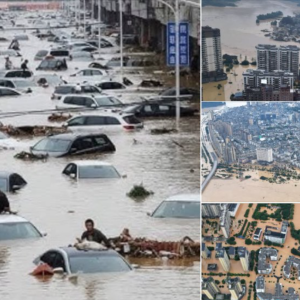BREAKING: Catastrophic Floods Devastate China — Cities Submerged, Tens of Thousands Displaced
July 2025 — CHINA.
Entire cities under water. Tens of thousands fleeing. Bridges crumbling. Rivers bursting. What’s unfolding across central and southern China is nothing short of a national emergency — a disaster on a scale that locals say they haven’t seen in decades.
Record-breaking rains have triggered catastrophic floods across vast regions of China, submerging towns, stranding residents on rooftops, and overwhelming rescue efforts. As rivers swell far beyond their banks and dams creak under the pressure, China faces a humanitarian crisis compounded by infrastructure collapse, crop failure, and growing fears of disease outbreaks.
This is the worst flooding event since the 1998 Yangtze River floods — and it’s still unfolding.
Torrents That Crushed Cities Overnight
The heaviest devastation has hit the provinces of Hunan, Jiangxi, Anhui, and parts of Chongqing and Guangxi, where rivers such as the Yangtze, Xiang, and Gan have swollen beyond historic flood levels.
In the city of Changsha, aerial footage shows entire districts submerged beneath muddy, raging waters. Streets have disappeared. Only the tips of traffic lights, rooftop signs, and apartment balconies peek above the surface. Residents who couldn’t evacuate in time are waving white sheets from windows, begging for rescue.
In Nanchang, the capital of Jiangxi, the Gan River overtopped its levees in multiple areas, flooding government buildings, schools, and hospitals. Entire wards had to be evacuated by boat.
The floodwaters arrived with horrifying speed. What began as a week of relentless rainfall turned into a full-blown catastrophe when dams and levees gave way, and flash floods tore through towns in the dead of night.
“We Had No Warning. The Water Just Came.”
Survivors tell chilling stories.
Li Wen, a 42-year-old father in Hengyang, recalled:
“We were sleeping when it started. Within an hour, the water was up to our waists. I grabbed my kids and put them on top of a wardrobe. Then the fridge floated by. I didn’t know if we’d live.”
Others weren’t so lucky. In Yongzhou, rescuers pulled the bodies of two elderly people from a submerged bus terminal. In rural villages, entire communities have been cut off, with no electricity, clean water, or working phone lines.
The military has been deployed in several provinces. Rescue teams using boats, helicopters, and makeshift rafts are working around the clock, but there are simply too many calls and not enough resources. Over 70,000 people have been displaced, with that number expected to climb.
Dams Under Pressure — Eyes on the Three Gorges
One of the greatest fears is the strain on China’s massive dam system, especially the Three Gorges Dam, the world’s largest hydroelectric power station. Authorities have issued reassurance that the dam is “stable,” but satellite images and hydrology reports suggest record water inflows into the Yangtze basin.
On social media, Chinese citizens express both fear and frustration.
“We’re not being told everything,” one user wrote on Weibo.
“If the Three Gorges Dam fails, the downstream cities will be gone.”
The Ministry of Emergency Management has acknowledged that multiple smaller dams have been breached or are leaking, including three in Hunan and two in Guangxi. Efforts to release water in a “controlled” manner through floodgates have caused secondary flooding in nearby areas.
Economic and Agricultural Impact
The timing of the disaster couldn’t be worse. July marks the peak of the rice-growing season in southern China, and the floods have drowned tens of thousands of acres of farmland.
In Jiangxi alone, officials estimate over 1.2 million acres of crops have been destroyed. Food prices are already rising in major cities like Shanghai, Guangzhou, and Wuhan.
Businesses have also been hit hard. Supply chains are disrupted. Roads and railways are underwater. Logistics hubs in Nanchang and Changsha have shut down. Several multinational factories have halted production due to damage or worker displacement.
Preliminary damage estimates already exceed $9 billion USD, and that figure is climbing daily.
Health Risks and Human Toll
With stagnant floodwater pooling in urban areas and temperatures climbing, public health officials warn of outbreaks of waterborne diseases such as cholera, hepatitis A, and skin infections.
Emergency shelters are overcrowded and under-supplied. Clean water and sanitation are becoming critical concerns. Hospitals that haven’t been flooded are overwhelmed with evacuees suffering from hypothermia, wounds, dehydration, and trauma.
Mental health professionals warn that the psychological impact will be long-lasting, especially among children who have lost their homes—or in some cases, their parents.
Government Response Under Scrutiny
While the Chinese government has mobilized large-scale relief efforts, including deploying over 50,000 troops, critics say the early warning systems failed in key areas.
Videos have emerged of residents receiving no evacuation notice before waters hit their neighborhoods. In some towns, local officials are accused of downplaying the risk to avoid panic—or political consequences.
International humanitarian agencies have offered support, but China’s leadership has not formally requested foreign aid as of now.
A Country Bracing for More
Meteorologists say the rain isn’t over. Typhoon-level storms are forming in the South China Sea, and further heavy rainfall is expected in the next 5–7 days. That means floodwaters may rise again—or shift to regions not yet affected.
Thousands remain missing. Hundreds of thousands are displaced. And millions more are holding their breath.
One rescuer in Jiangxi put it simply:
“The river used to feed our people. Now it’s trying to take them away.”
Developing Story…
Stay tuned for updates on rescue efforts, weather warnings, and the long road to recovery for the people of flood-stricken China.

